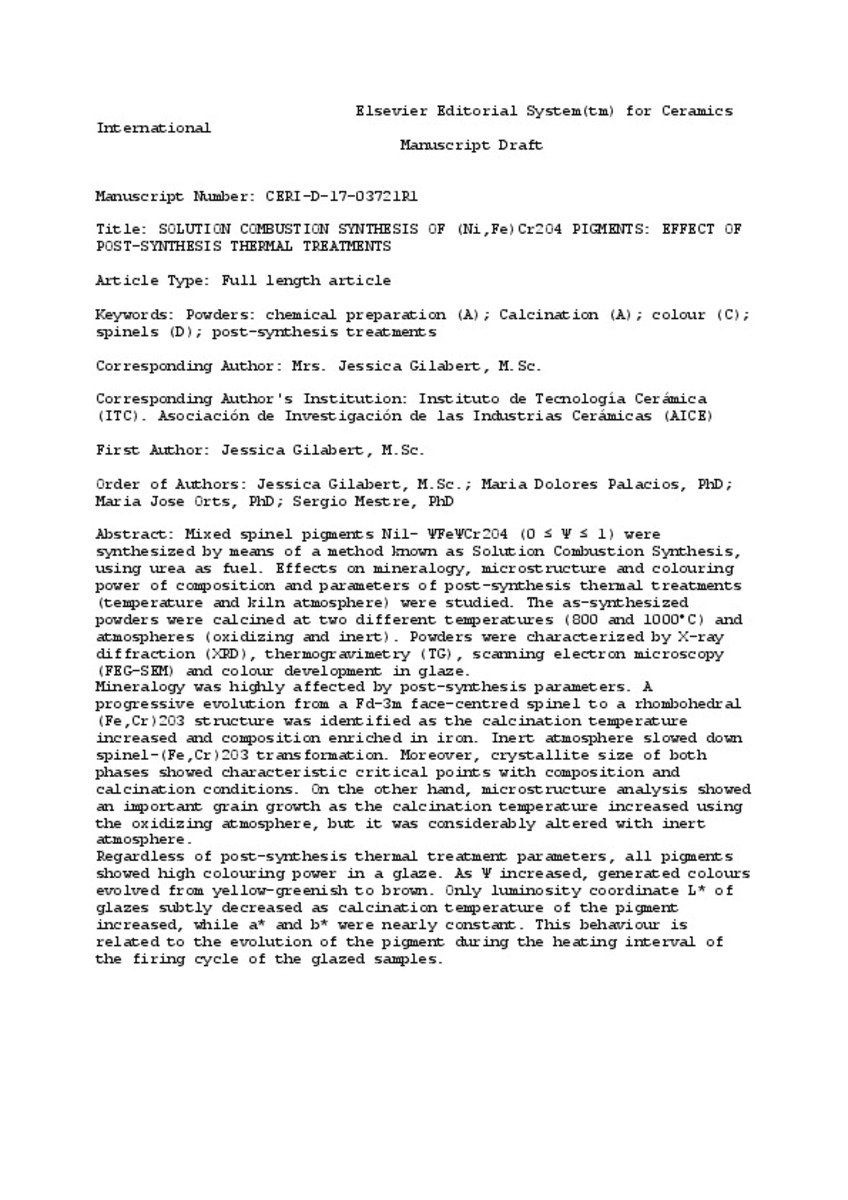Mostrar el registro sencillo del ítem
Solution combustion synthesis of (Ni,Fe)Cr2O4 pigments: Effect of post-synthesis thermal treatments
| dc.contributor.author | Gilabert, Jessica | |
| dc.contributor.author | Palacios Tejero, María Dolores | |
| dc.contributor.author | Orts Tarí, María José | |
| dc.contributor.author | Mestre Beltrán, Sergio | |
| dc.date.accessioned | 2018-01-08T10:33:52Z | |
| dc.date.available | 2018-01-08T10:33:52Z | |
| dc.date.issued | 2017-10-15 | |
| dc.identifier.citation | GILABERT, J., et al. Solution combustion synthesis of (Ni, Fe) Cr2O4 pigments: Effect of post-synthesis thermal treatments. Ceramics International, 2017, vol. 43, no 15, p. 12789-12798 | ca_CA |
| dc.identifier.issn | 0272-8842 | |
| dc.identifier.issn | 1873-3956 | |
| dc.identifier.uri | http://hdl.handle.net/10234/171599 | |
| dc.description.abstract | Mixed spinel pigments Ni1− ΨFeΨCr2O4 (0 ≤ Ψ ≤ 1) were synthesized by means of a method known as Solution Combustion Synthesis, using urea as fuel. Effects on mineralogy, microstructure and colouring power of composition and parameters of post-synthesis thermal treatments (temperature and kiln atmosphere) were studied. The as-synthesized powders were calcined at two different temperatures (800 and 1000 °C) and atmospheres (oxidizing and inert). Powders were characterized by X-ray diffraction (XRD), thermogravimetry (TG), scanning electron microscopy (FEG-SEM) and colour development in glaze. Mineralogy was highly affected by post-synthesis parameters. A progressive evolution from a Fd-3m face-centred spinel to a rhombohedral (Fe,Cr)2O3 structure was identified as the calcination temperature increased and composition enriched in iron. Inert atmosphere slowed down spinel→(Fe,Cr)2O3 transformation. Moreover, crystallite size of both phases showed characteristic critical points with composition and calcination conditions. On the other hand, microstructure analysis showed an important grain growth as the calcination temperature increased using the oxidizing atmosphere, but it was considerably altered with inert atmosphere. Regardless of post-synthesis thermal treatment parameters, all pigments showed high colouring power in a glaze. As Ψ increased, generated colours evolved from yellow-greenish to brown. Only luminosity coordinate L* of glazes subtly decreased as calcination temperature of the pigment increased, while a* and b* were nearly constant. This behaviour is related to the evolution of the pigment during the heating interval of the firing cycle of the glazed samples. | ca_CA |
| dc.format.extent | 10 p. | ca_CA |
| dc.format.mimetype | application/pdf | ca_CA |
| dc.language.iso | eng | ca_CA |
| dc.publisher | Elsevier | ca_CA |
| dc.rights | Copyright © Elsevier B.V. | ca_CA |
| dc.rights.uri | http://rightsstatements.org/vocab/InC/1.0/ | * |
| dc.subject | powders: chemical preparation (A) | ca_CA |
| dc.subject | calcination (A) | ca_CA |
| dc.subject | colour (C) | ca_CA |
| dc.subject | spinels (D) | ca_CA |
| dc.title | Solution combustion synthesis of (Ni,Fe)Cr2O4 pigments: Effect of post-synthesis thermal treatments | ca_CA |
| dc.type | info:eu-repo/semantics/article | ca_CA |
| dc.identifier.doi | https://doi.org/10.1016/j.ceramint.2017.06.168 | |
| dc.relation.projectID | Universitat Jaume I / Project Nr. P11B2015-04 | ca_CA |
| dc.rights.accessRights | info:eu-repo/semantics/openAccess | ca_CA |
| dc.relation.publisherVersion | Ceramics International, 2017, vol. 43, no 15 | ca_CA |
| dc.date.embargoEndDate | 2019-10-15 | |
| dc.type.version | info:eu-repo/semantics/submittedVersion | ca_CA |
Ficheros en el ítem
Este ítem aparece en la(s) siguiente(s) colección(ones)
-
QUI_Articles [296]







